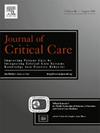危重COPD患者白蛋白校正阴离子间隙与住院死亡率的关系:来自eICU合作研究数据库的多中心回顾性研究
IF 2.9
3区 医学
Q2 CRITICAL CARE MEDICINE
引用次数: 0
摘要
背景:重症监护病房(ICU)的慢性阻塞性肺疾病(COPD)患者往往预后较差。早期评估疾病严重程度对于及时干预以改善结果至关重要。白蛋白校正阴离子间隙(ACAG)反映代谢性酸中毒程度,减少了低白蛋白血症对结果的干扰,是ICU COPD患者的合适指标。本研究旨在探讨慢性阻塞性肺病ICU患者ACAG与住院死亡率的关系。方法:我们从eICU数据库中提取4304例icu住院COPD患者的数据,并根据ACAG四分位数将其分为四组。采用Logistic回归模型分析慢性阻塞性肺病危重患者ACAG与住院死亡率的关系。采用限制性三次样条(RCS)进一步探讨ACAG与住院死亡率之间潜在的非线性关联。采用受试者工作特征(ROC)和决策曲线分析(DCA)比较ACAG和阴离子间隙的预测性能。进行亚组分析以调查潜在的相互作用。结果:较高的ACAG水平是重症COPD患者住院死亡率的有力预测因子。ACAG水平升高与院内死亡风险增加之间存在非线性关系,当ACAG超过15时,死亡风险急剧增加。与阴离子间隙相比,ACAG具有更好的预测能力。亚组分析显示,ACAG对年龄小于65岁的患者有更强的预测价值。结论:ACAG可有效预测ICU COPD患者住院死亡率,预测能力优于阴离子间隙。ACAG可以帮助COPD危重患者的早期疾病监测和风险分层。本文章由计算机程序翻译,如有差异,请以英文原文为准。
The association between albumin-corrected anion gap and in-hospital mortality in critically ill COPD patients: A multicenter retrospective study from eICU collaborative research database
Background
Patients with chronic obstructive pulmonary disease (COPD) in the intensive care unit (ICU) often have poor prognoses. Early assessment of disease severity is crucial for timely interventions to improve outcomes. The albumin-corrected anion gap (ACAG) reflects the degree of metabolic acidosis and reduces the interference of hypoalbuminemia in the results, making it a suitable marker for COPD patients in the ICU. This study aims to explore the association between ACAG and in-hospital mortality in ICU patients with COPD.
Methods
We extracted data from 4304 ICU-admitted COPD patients from the eICU Database and categorized them into four groups based on ACAG quartiles. Logistic regression models were used to analyze the relationship between ACAG and in-hospital mortality in critically ill COPD patients. Restricted cubic spline (RCS) was employed to further explore the potential non-linear association between ACAG and in-hospital mortality. Receiver operating characteristic (ROC) and decision curve analysis (DCA) were used to compare the predictive performance of ACAG and the anion gap. Subgroup analyses were performed to investigate potential interactions.
Results
Higher ACAG levels were a strong predictor of in-hospital mortality in critically ill COPD patients. A non-linear relationship was observed between elevated ACAG levels and increased risk of in-hospital mortality, with a sharp increase in mortality risk when ACAG exceeded 15. Compared with the anion gap, ACAG demonstrated superior predictive ability. Subgroup analysis revealed that ACAG had a stronger predictive value in patients younger than 65 years.
Conclusions
ACAG is an effective predictor of in-hospital mortality in ICU patients with COPD, offering better predictive power than the anion gap. ACAG can assist in early disease monitoring and risk stratification in critically ill COPD patients.
求助全文
通过发布文献求助,成功后即可免费获取论文全文。
去求助
来源期刊

Journal of critical care
医学-危重病医学
CiteScore
8.60
自引率
2.70%
发文量
237
审稿时长
23 days
期刊介绍:
The Journal of Critical Care, the official publication of the World Federation of Societies of Intensive and Critical Care Medicine (WFSICCM), is a leading international, peer-reviewed journal providing original research, review articles, tutorials, and invited articles for physicians and allied health professionals involved in treating the critically ill. The Journal aims to improve patient care by furthering understanding of health systems research and its integration into clinical practice.
The Journal will include articles which discuss:
All aspects of health services research in critical care
System based practice in anesthesiology, perioperative and critical care medicine
The interface between anesthesiology, critical care medicine and pain
Integrating intraoperative management in preparation for postoperative critical care management and recovery
Optimizing patient management, i.e., exploring the interface between evidence-based principles or clinical insight into management and care of complex patients
The team approach in the OR and ICU
System-based research
Medical ethics
Technology in medicine
Seminars discussing current, state of the art, and sometimes controversial topics in anesthesiology, critical care medicine, and professional education
Residency Education.
 求助内容:
求助内容: 应助结果提醒方式:
应助结果提醒方式:


